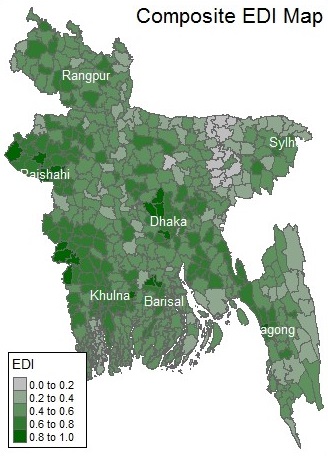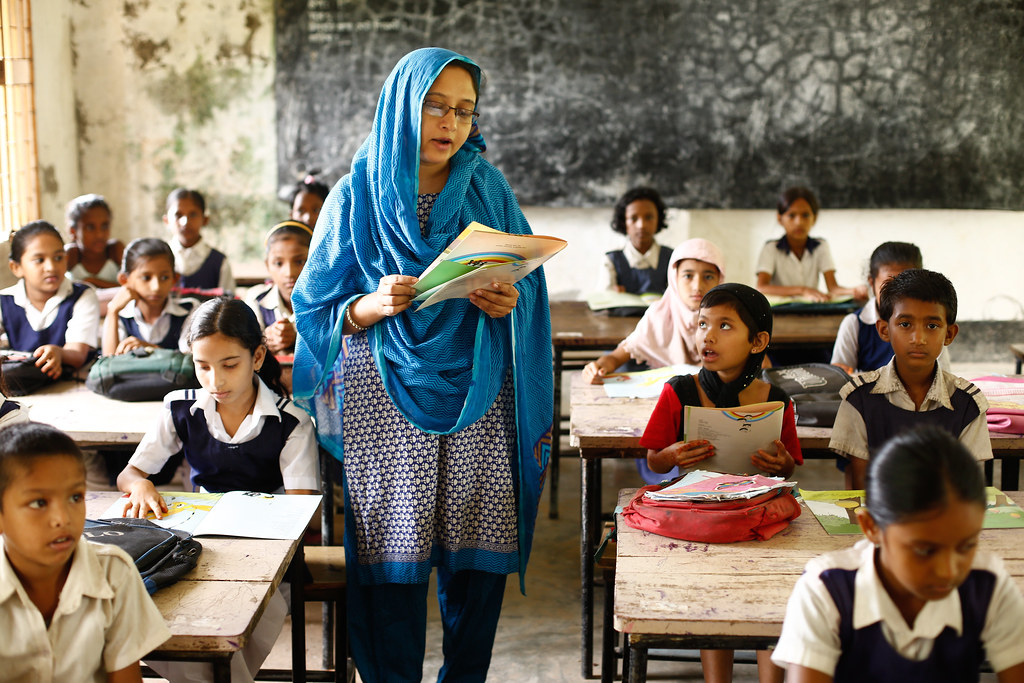
Selim Raihan and Mansur Ahmed
Sound knowledge on educational performances of different regions across the country can be helpful in the decision-making process for better resource allocation and policy formulation. A multidimensional composite measure of educational development, that captures many dimensions such as access, inputs, quality, gender-parity, and outcome, would enable policymakers to target and to channel scarce resources in lagging regions more efficiently.
This paper develops a multidimensional composite index for the primary education development for 483 upazilas (sub-districts) in Bangladesh and identifies the lagging regions for potential policy intervention. More specifically, this paper constructs the Education Development Index (EDI) for the primary education sector of Bangladesh. This index facilitates cross-sectional analysis of the levels of attainment in education among different regions of Bangladesh. Furthermore, it draws policy attention to crucial parameters for achieving equity in access and attainment in educational development.
Bangladesh has one of the largest primary education systems in the world with an estimated 16.4 million primary school-aged children (6 to 10 years). This study uses the data from a census that was carried out in 2011, which covered all 11 types of primary schools with a total number of more than 80,000 schools. Education Management of Information System (EMIS) division of the Directorate of Primary Education (DPE) under the Ministry of Primary and Mass Education (MoPME) undertook the census.
Five broad parameters and 19 sub-parameters (individual indicators) are used in the construction of EDI. The broad parameters are (i) Access, (ii) Infrastructure, (iii) Quality, (iv) Gender Equity, and (v) Outcome. This study has applied the Principal Component Analysis (PCA) method for each broad parameter and calculated weights for each of the indicators within the broad parameter. (For detail methodology of EDI construction and list of indicators, see Raihan and Ahmed, 2016). The objective of PCA is to reduce the dimensionality (number of indicators) of the data set but retain most of the original variability in the data. The overall EDI constructed for this analysis is again a weighted summation of five broad EDIs – access EDI, infrastructure EDI, quality EDI, gender equity EDI and outcome EDI, with weights derived from the PCA on these five EDIs. The index value of 1 indicates the highest educational development with 0 as the lowest development.
Analysis of the aforementioned census data suggests that despite indicators related to the accessibility of schools showed good scenarios, still about 20% schools were not easily accessible to the neighboring residents. Astonishingly, only 20% of schools enjoyed electricity access. Classrooms at the primary schools in Bangladesh were quite crowded as the student-room ratio was 38. The student-teacher ratio was also very high, implying crowded classrooms with a low degree of interaction between students and teachers. Still, a significant proportion of teachers in primary schools were without a bachelor’s degree. In terms of gender parity at the primary school enrolment, not all upazilas achieved gender parity. Though the Ministry of education set a target that the ratio of female to male teachers should be above 60%, the observed female to male teachers ratio in the census data was about 53%, which suggests a need for renewed efforts to reach that goal. Another important indicator related to gender equity is the percent of schools with girls’ separate toilets. The census data shows that only 40% of schools had separate toilets for girls. Despite Bangladesh achieved remarkable success in primary school enrollment, the average pass rate at grade V and school attendance rates were 87% and 85% respectively with wider variations among the upazilas. On average, 1 out of 10 students needed to repeat the same class and 1 out of 20 students dropped out of school.
In terms of access EDI (constructed using two sub-parameters – schools per thousand populations and accessibility of schools), most upazilas performed in the mid-range (0.4 – 0.6), suggesting a significant scope of improvement in terms of accessibility of schools. However, the upazilas around the ‘haor’ (large water bodies) regions in Sylhet division and in Mymensingh division and the upazilas from Chittagong Hill Tracts (CHT) lagged behind other upazilas badly in terms of accessibility. Some other upazilas along the Jamuna River and the Padma River (the ‘char’ lands) also performed poorly. While improvement of accessibility of schools is necessary for most upazilas, these lagging upazilas warrant special attention for their geographical locations. Upazilas located in metropolitan areas, in contrast, performed well in terms of accessibility.
The patterns of infrastructure EDI (constructed using five sub-parameters – school with safe water, school with electricity, school with toilet per 100 students, average room condition of the school, and student-room ratio) were similar to those of the access EDI. However, the performance of upazilas in terms of infrastructure EDI was worse than that of access EDI. A large number of upazilas were in the lower mid (0.2 – 0.4) of infrastructure EDI, while most of them belonging to the Chittagong Hill Tracts and Mymensingh division. Upazilas in the southwest coastal region and along the upper Jamuna River in the Rangpur division also performed poorly.
In terms of quality EDI (constructed using three sub-parameters – student-teacher ratio, qualification of teachers, and availability of teaching-learning materials), though some number upazilas performed in the upper-middle-range (0.6 – 0.8), only a few upazilas were in the top quintile. In fact, quite a few upazilas were in the lower middle range (0.2 – 0.4). Most of the top ten performing upazilas were from metropolitan areas.
In terms of equity EDI (constructed using four sub-parameters – ratio of girls among total students, the ratio of female among teachers, schools having a separate toilet for girls, and gender equity in dropout rate), most upazilas in Bangladesh performed in the lower middle of the ladder (0.4 – 0.6). Some upazilas performed even poorly. Therefore, despite the ‘satisfactory’ level of gender equity in primary education at the national level, gender parity in primary education is a serious issue in a large number of upazilas. Like the access EDI, upazilas from ‘haor’ regions performed poorly in gender equity. Quite understandably, upazilas from urban areas were among the top-performing upazilas in terms of equity EDI.
In terms of outcome EDI (constructed using five sub-parameters – gross enrolment ratio, pass rate at grade five, attendance rate, dropout rate, and repetition rate), most upazilas performed in the mid-range, implying a room for improvement for all upazilas. Upazilas from the ‘haor’ region, Chittagong Hill Tracts, and poverty-stricken North-Bengal were the worst performers.
The map presented depicts the spatial distribution of composite EDI (constructed using five EDIs – access EDI, infrastructure EDI, quality EDI, gender equity EDI, and outcome EDI). The map shows that very few upazilas were in the highest range (0.8 – 1.0) of EDI. In fact, not many upazilas were in the range of 0.6-0.8 of the EDI score. Most upazilas were concentrated in the range of 0.4-0.6. Most of the top ten upazilas were from large metropolitan areas such as Dhaka, Chittagong or Khulna. Lowhajong of Munshiganj and Shibpur of Norsingdi were only the exceptions and these upazilas were also located in close proximity to the capital city Dhaka. Upazilas in the ‘haor’ region of Sylhet division and Mymensing division and upazilas from the CHT was fatally lagging behind all other upazilas in terms of primary education development. All the bottom ten upazilas were either from the ‘haor’ region or from the CHT. Though the population density in the CHT is low, the upazilas in the ‘haor’ region is home to a sizeable portion of the population of the country. Thus, these lagging regions warrant special attention to improve the overall development of primary education in Bangladesh.
The aforementioned analysis suggests that despite many achievements during the past decades, major improvements are still needed in Bangladesh in order for all children to receive the benefit of quality primary education. Opportunities for good quality primary education in Bangladesh are limited by inequalities associated with wealth, location, ethnicity, gender, and other factors. The major challenges thus include addressing poor quality of education, high dropout rates, promotion of equity and accessing education, and targeted programs for lagging regions.
Reference:
Raihan, S. and M. Ahmed. (2016). Spatial divergence of primary education development in Bangladesh through the lens of the Education Development Index (EDI). MPRA paper 71177.




RECENT COMMENTS